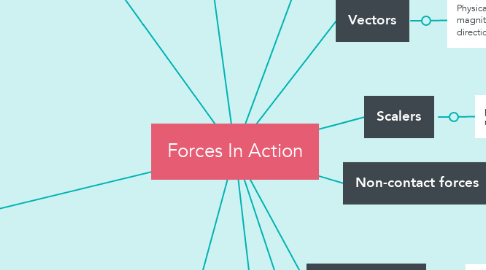
1. Properties of Forces
1.1. A push/pull force acting on an object because of their interaction
1.2. Measured in Newtons (N)
1.3. Can change the shape of an object
1.4. Can change an objects state of rest or motion (make it move differently to how was initially)
2. Newtons Laws
2.1. Newton's 1st Law- if the forces on an object are balanced the resultant force is 0. Therefore, if an object is at rest (not moving), it stays stationary OR if it is moving, it will continue to move at the same speed and direction.
2.1.1. Links to his 3rd law- if two forces at upon an object with a resultant force of 0, they must be equal and opposite in direction.
2.2. Newton's 2nd Law- The acceleration of an object is proportional to the resultant force on the object, and inversely proportional to the mass of the object.
2.3. Newton's 3rd Law- if two objects interact with each other, they exert equal and opposite forces on each other.
3. Resultant Forces
3.1. Resultant force- a single force that has the same effect as all the forces action on an object. If it is 0, the forces are balanced. If it is 0<, the speed or direction of the object will change. How much it will change depends on the size & direction of the force.
3.1.1. If it is 0, the forces are balanced (Newtons 1st Law), the object will not change.
3.1.2. If it is greater than 0, the speed or direction of the object will change. How much it changes depends on the size & direction of the force.
3.1.2.1. If an object is acted on by 2 unequal forces acting in opposite directions, the resultant force is: -equal to the difference between the 2 forces -in the direction of the bigger force
3.1.2.2. If an object is acted on by 2 unequal forces in the same direction, the resultant force is: -equal to the sum of the 2 forces -is in the same direction.
4. Moment Forces
4.1. moment,M (Nm) = force, F (N) x perpendicular distance from the line of action of the force to the pivot, d (m)
4.2. Can be increased by increasing the magnitude of the force, using a longer distance.
4.3. Principle of moments for an object that is not moving.
4.3.1. the sum of the clockwise moments about any point = the sum of all the anticlockwise moments about that point.
4.4. Is a measure of the turning effect of the force on an object
5. Contact forces
5.1. forces that occur between two objects that are touching
5.1.1. friction, air resistance, tension and normal contact forces
6. Scalers
6.1. physical quantities with a magnitude only
6.1.1. time, speed, distance, mass, energy and power
7. Vectors
7.1. Physical quantities with a magnitude (size) & direction
7.1.1. can be represented as an arrow: the direction= its direction, its length= its magnitude
7.1.2. acceleration, force, momentum, weight and gravitational field strength (g)
8. Non-contact forces
8.1. forces that occur between two objects that are at a distance to each other
8.1.1. magnetic force, electrostatic force, gravity
9. Leavers
9.1. A lever used as a force multiplier exerts a greater force than the force applied to the leaver by the effort.
9.1.1. A pivot of a force multiplier is nearer to the line of action of the force it exerts than to the force applied to it.
10. Centre of gravity
10.1. Think of the mass of an object in one single concentrated point
10.1.1. The centre of mass for a uniform ruler is in the middle.
11. Suspended equilibrium
11.1. If you suspend an object and release it, it will come to rest with its centre of mass directly below the point of suspension.
11.1.1. The object is in equilibirum- its weight does not exert a turning effect on the object.
